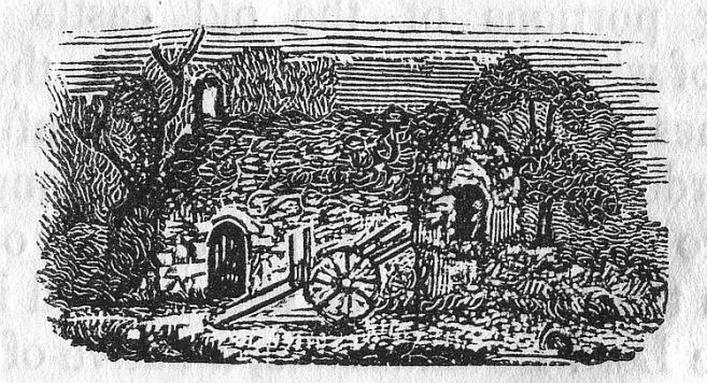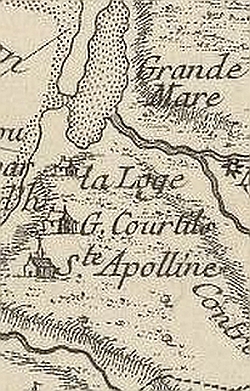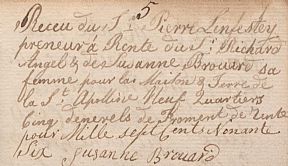Lost things: Old Red House, St Saviour's, 1891

Letters from the Star, April 1891. Blondel and Andros, Brouard, Dumont, and Angel, at St Apolline. St Apolline's Chapel is first mentioned as belonging to Nicolas Henry in 1394; it was then called Notre Dame de la Perelle. The woodcut shows the chapel in use as a barn, from Bellamy's Pictorial Guide of 1843, in the Library collection.

See also: Lost things: Les Maindonnaux, 1901; Les Maisons aux Comtes, 1915; Notre Dame de la Perelle | Priaulx Library
The history of the related house, known as 'La Sainte Appoline,' or 'La Poline,' or 'L'Appolane,' is discussed in a very interesting and detailed article by T F Priaulx in the Quarterly Review of the Guernsey Society, Autumn 1954, X (1-2), pp. 17 ff.
Duncan's The History of Guernsey &c, 1841, p. 403:
It is not improbable that there was a religious house in the neighbourhood of the Chapel of St. Apolline, for portions of mullions and tracery belonging to a large window have been discovered in the house opposite the chapel. At the back of this house there is also an old building in the walls of which are the remains of arched windows and a fireplace; this was probably the kitchen of the religious establishment. The proprietor of these premises [the farm took its name from the chapel; Mr Lenfestey] has in his possession the clapper of the bell, and also portions of the sundial and ornamented stone cross, which, it is said, stood on the summit of the east gable of St Apolline.
Home Words, 1875: 'Chapels anciently existing at St Saviour's':
The building (St Apolline's Chapel) stands close to and projects a little on the high road, on the opposite side of which to the south of the Chapel is a very ancient and substantially-built farm-house, which is traditionally said to have been the residence of the officiating priest. It is quite as probable that it was the manor-house of the founder, Nicolas Henry. In it were preserved the iron-clapper of a bell, which is said to have belonged to that of the Chapel, and some wrought stones, which probably formed the supports of the altar-slab. A more interesting relic, however, which is said by tradition to have come from this chapel, is a small silver burette, one of a pair, such as are used in the Roman Catholic Church to contain the wine and the water employed in the celebration of the mass. It bears the inscription SANCTE PAULE ORA PRO NOBIS; and on the lid is the letter A denoting that it was the vessel to contain the water. It is in the possession of the ancient family of the Guilles of St George, who also preserve two small candlesticks of different patterns, which are said to have formed part of the furniture of this Chapel.
Until the year 1873 when, an opportunity presenting itself, the States of Guernsey came forward to purchase the building with a view of preventing so interesting a relic from falling into utter ruin, the Chapel belonged to the farmhouse of which we have spoken above, and served the purpose of a stable or place for storing fuel.
REMINISCENCES OF OLD SARNIA
SIR: While driving in St Saviour’s parish, near Perelle, through the Grande Rue, near St Appoline Chapel, founded by Nicolas Henry, or Haries, in the 14th century, I was grieved to see one of the oldest manors in the parish being pulled down. It has a quadrangle and the remains of what appears to have been a chapel communicating with the house. The building must be centuries old, and for the period, the most important place in the neighbourhood. It probably belonged to either the Blondels,1 Henries, or de Garis. I would strongly recommend the Guernsey Historical and Antiquarian Society making a tour of inspection before this venerable fabric disappears altogether and report upon it.
I am, dear Sir, Yours truly, ANTIQUARIAN. April 7, 1891.
SIR:- Allow me to inform your correspondent 'Antiquarian' that he is quite correct in a conjecture as regards the old house, now partly demolished, near St. Apolline’s Chapel in the parish of St Saviour, which, at one time, belonged to a family by the name of Blondel. As a matter of fact, it is not a manor house, being situated on the Fief St. Michel, near the boundary of Fief Le Comte. Though, for many years, acquainted with the locality, I have never heard of a chapel at any time, communicating with the house.
These Blondels were, in their day, great men in the parish. At that date the Militia was not organised in Regiments, but there were one, or more, Companies, in each parish, and two, at least, of the owners of the house were, in turn, Captains of the St Saviour’s Company. There is a tradition to the effect that during the Captaincy of one of them the Company marched into town, with a view to request, or compel, the then Governor, or his Lieutenant, to relieve the country people of the heavy burdens—tailles—he had imposed upon them. That the Company reached its destination appears probable, but it appears equally probable that it did not return with flying colours—had such been in its possession – for the guns were left behind, and these guns were the two built up in a wall at the top of Fountain Street, from whence they were removed some years since, when the frontage of the houses was thrown back. It is also said that on the day following the exploit, soldiers were sent to capture the Captain, but could not find him, although they went to the very loft where he was hidden, under bundles of fern. They removed all except the lower ones which they prodded with their bayonets, or swords, and though he got a closer acquaintance with cold steel than was pleasant, he managed to keep his own counsel and escaped detection.
The house now belongs to Mr John Paint, who, I understand, intends to build on the same site. It has come to him through the Roland family, who held it some hundred and sixty years ago, but whether they got it through purchase or inheritance, I cannot tell.
It may interest your correspondent to know that a grave, such as have occasionally been met with in the locality, was found the other day, some two or three hundred yards from the old house. It was that of a grown up person, the sides were roughly built up with stones, and where the head of the corpse would lie, it was covered with a rounded stone, comparatively smooth, something like an inverted copper, weighing about half a ton, and the top ten or twelve inches below the surface of the soil. In this case there appears to have been nothing imperishable in the grave.
I am Sir, Yours truly, A Son of old Sarnia. April 10.
From Amias C. Andros.
The old house in question was a veritable Type of the architecture of two or three centuries ago. With its semi-quadrangular plan, its grand Norman arches, massive quoins and solid Cyclopean masonry, hoary with age, toned and weather-stained, and lichened and beautified as only Time can beautify it, seemed an institution which it would be almost sacrilege to assail.
I had a special interest in the house because it had always been pointed out to me as having once belonged to my ancestors. The héritage of St Apolline was in the possession of the Andros family for over a century, and it came to them in 1671 by the marriage of George Andros, formerly Cornet of Dragoons in Prince Rupert's Regiment, but then Captain of the St Saviour's Company, with Anne Blondel, heiress of the estate. It descended to their son George (afterwards Governor of Alderney), who sold it in 1699 to his cousin Amias Andros married to Magdalena Mansell. Amias's father, in 1661, and great-grandfather, in 1570, had both married into the Blondel family of the Piques, so that the connexion between the Androses and the Blondels was an extremely close one. The heritage descended to Amias' daughter Elizabeth—as an old pedigree has it, de la Poline—who married a De Garis and, after his death, in 1772, sold it to Henry Brouard and Sarah Dumont.
It was while St Apolline was in possession of the Androses that the famous silver-gilt flagon was found in the Chapel, and generously bestowed by one of my predecessors on the Guille family. Thus passed away the last relic of our connexion with St Apolline. And now the red house over against the Chapel, whether it really was the family manse or not during the period I have referred to, is going, going, gone! It is not the only one that I could prate about, not the only temple I have seen destroyed.2 &c. [Extracts] 18th April, 1891.
CHAPEL OF ST APOLLINE.
SIR: [The little flagon or cruet mentioned in Amias Andros' letter as found in the Chapel;] I have heard from others that it was found in the neighbourhood; but I am very doubtful whether it ever belonged to that chapel. The cruet bears the inscription Sancte Paule ora pro nobis, as though it had been made for use at an altar devoted to St Paul. The letter A on the cover has sometimes been thought to stand for Apolline; but, of the two cruets used at Mass, the one which held water was often marked A (aqua), while the other bore the letter V (vinum). As the chaplain of St Apolline usually held other appointments in the Island, I am inclined to suppose that the cruet was the private property of some priest here, and perhaps originally belonged to an altar of St. Paul, either in Guernsey or elsewhere. Whatever its history, the cruet is undoubtedly an exquisite piece of workmanship, and I should rejoice if its owner would restore it to the use of one of the churches in his native island.3
PAROCHUS. April 21, 1891.
ST APOLLINE. From Amias C. Andros. [He cannot prove the chalice was after all found in the chapel.] The Reverend George Guille, in whose possession the relic now is, says that 'his impression as a young man was that his father, George Métivier, and others said it was found in the house opposite.' Edgar MacCulloch was of the opinon that 'the cup may have been used in the Chapel, but was doubtful if it had long belonged to it.' [Andros agrees.] Studying the conformation of the letter 'A' on the chalice, as accurately depicted on a lithograph by the late W. C. Lukis, Esq., I consider it just as likely to form a monogram comprising the letters T.A. [Andros surmises that the cup belonged to Thomas Andros, Seigneur de Samares, b. 1571, whose grandson George gained possession of the Chapel through his wife Anne Blondel, and that the cup belonged to the house at La Poline, rather than to the Chapel.]
OLD SARNIA. SIR,—The discrepancy between your correspondent A.C.A.'s statements and mine as regards the ownership of the old house, now in course of demolition, near St Appoline, is only apparent. We refer to two different héritages, both on the same road, joining one another, and at one time, possibly, one estate, or both belonging to the same family.

The Henry Brouard and Sarah Dumont who purchased the property still known locally as La Poline, had a daughter, Susanne, who, I presume, married an Englishmen named Richard Angel;4 for in my young days I have heard elderly people speak of Richard Ange et sen biau-père Henry Brouard, as living at St Appoline, and of some the quaintly expressed sayings of the former. This Richard Angel made a délaissance in favour of Susanne Brouard, his wife or sister-in-law, and was, for a time, by her heirs, believed to be the rightful heir to a large property in Chancery, which many researches were made some forty years ago, but without success.
I am Sir, Your obedient servant, A SON OF OLD SARNIA. April 24th, 1891.
1 Letter Patent 20th July 1394, (in the Greffe Vol. 3, BI.1. (1)); Nicolas Henry alienates 20 s. of rent issuing from his manor in St Saviour to pay for 'a chaplain to celebrate divine service daily in the chapel of St Mary de la Perel, in the said manor.' For genealogy and house plans see Priaulx, T. F., Les Grands Courtils, St Saviour's', in The Quarterly Review of the Guernsey Society, QRGS XI (3), Autumn, 1955, pp. 51 ff., where he explains that there were two houses belonging to the Blondel family near St Apolline's chapel; and 'La Porte, St Saviour's', XIII (4), Winter 1957, pp. 76 ff. The latter, dating from c. 1587, was owned by John Blondel, a younger brother of Leonard Blondel of Les Grands Courtils. For a clear outline of the history of this house and its sister, Les Grands Courtils, see Wessex Archaeology's Conservation Plan for St Apolline's Chapel, a copy of which is in the Library. See again T. F. Priaulx on St Apolline's Chapel in The Quarterly Review of the Guernsey Society, X, 1954, and Bramall, G., 'The Chapel of St. Apolline, Perelle, St. Saviour,' The Review of the Guernsey Society, 1998. See Guille of the Rohais & St George, p. 22, for a letter under seal of 12 April 1496, in which Edmond Cheney sells various rents to Nicolas Guille, including from Philippin and Jan de Quettehou (de Gethou), Guillaume Robilliart, and Johan de France 'et sont les dites rentes tournées et assignées au dit Nicolas Guille pour certaine somme d'or et d'argent que le dit NG avoit poyé pour le patronnage de Saint Apollyne, lequell le dit Nicollas a delivrey au dit EC & es syens hers.' Nicolas Guille provided the original Royal patent and a letter under seal of the Bishop of Coutances as proof of his ownership.
2 On a similar theme, see 'The Last of the Vale Priory', Report and Transactions of the Société Guernesiaise, X (3), 1928, p. 229-30, including photographs of the Priory's gable wall taken by Edith Carey (the originals are in the Library), knocked down to make way for packing sheds after the States declined to buy the site. The Reverend George Lee led a contingent of the Societe to visit the Vale Church; the very Rev. Canon T Bell, both the rector of the Vale and Dean, lent them the key to the Monks' garden, where they inspected the remains of the old monastery. The gable end was in a very good state of preservation; 'leaning against it is an archway in red granite which is in perfect condition. The other portions of the construction have partly collapsed and are now only heaps of stone.' In the St James' District Parish Magazine of June, 1874, he says: 'To the south-east of the Church is an old farm-house which still bears the name of L'Abbaye, and which, without doubt, occupies the site of the original priory. Even at the present day it is easy to trace part of the walls of the earlier edifice which, however, was in a ruinous state as early as the reign of Henry IV, for we find Sir John De Lisle, Governor of Guernsey, writing to the Privy Council about the year 1406 for permission to use the timber of the building for the repairs of Castle Cornet, and alleging in his letter that the priotry had fallen into decay.' He quotes in an annotation the Rev. W. C. Lukis: 'There are buttresses of two stages supporting the south wall segmental arches in other parts of the house.'
3 Given 1895 to the Town Church by the Rev. Hubert Stevens-Guille in memory of his father, and used for the first time at the dedication of the new altar in 1896. A companion wine-cruet of similar design was gifted by Mrs Balfour Cockburn. In a lecture given in 1920 and reported in the Star, Decmeber 2, 1920, 'The Church Plate of the Channel Islands', Spencer Carey Curtis remarks, "The Guille cruet, dating about 1535-40, ... had been given to St Barnabas by the Reverend H G de C Steves-Guille and was worth from £3,000 to £4,000." Carey Curtis illustrated his talk and corresponding article with photographs, the glass plates for which are in the Priaulx Library collection.
4 The ownership of Richard Angel and Susanne Brouard is confirmed by a recent donation to the Priaulx Library of the rent-book of Jean Lenfestey, beginning in 1790, in which he records his payments of annual rent to Richard and Susanna Angel, from whom he has purchased the property 'la maison et terres de la Sainte Apolline' [sic]. Richard Angel and his attempts at Guernsey French are discussed by T F Priaulx in 1954 QRGS article cited above; Henry Brouard bought the property in 1772, on the death of Elizabeth Andros. 'By 1808 the property had passed into the hands of Jean Lenfestey fils Pierre. The family still owned the house in 1877, together with the larger part of the 'courtil et portière de la Chapelle.' John Bonamy Le Prevost was the owner in 1896, followed by Denys Dumaresq Le Cras. Mr John F Le Page is the present owner of this interesting and historic old Maison de famille.'
